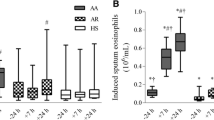Abstract.
Objective and Design: The main objective was to establish the level of serum ECP in a group of adult asthmatic patients with acute exacerbation and the following resolution and in another group of adult, stable asthmatic patients during reduction of inhaled steroids.¶Subjects and Treatment: Acute group: Twenty-one asthmatic patients admitted to the asthma clinic with acute deterioration of their asthma were set on oral steroids which were reduced to 0 within one week. Reduction group: Forty-four stable asthmatic patients on maintenance inhaled steroids were included and, on the basis of their peak expiratory flow (PEF) values, adjustments in the doses of steroids were made. Control group: Twenty stable asthmatics on a constant dose of inhaled steroids were enrolled as controls.¶Methods: All patients registered daily PEF measurements and spirometry was performed at each visit. Blood samples were drawn and analysed for eosinophil cationic protein (ECP), myeloperoxidase (MPO), eosinophils and neutrophils.¶Results: ECP was low and within the normal range for all three groups at study entry. (Acute group = 8.4 μg/l, reduction group = 3.7 μg/l and control group = 4.6 μg/l). Nevertheless, the value in the acute group was significantly higher than in the control group (p = 0.005). The levels in the acute group decreased significantly (p = 0.004) after one week on oral steroids. No significant changes in ECP were observed in the reduction group or in the control group during the follow-up period. The lung function was low in the acute group at inclusion, forced expiratory volume in one second (FEV1) = 47.1% of predicted, and increased significantly during the treatment period (p = 0.006). The patients in the reduction- and control group showed small variations in lung function during the whole study, FEV1 >70% and PEF > 80% of predicted, respectively. No correlation between atopy and ECP was found in the patients irrespective of the stage of disease.¶Conclusions: This study suggests that the resolution of acute asthma exacerbations during treatment could be followed using ECP determinations. In stable asthmatics on inhaled steroids and with normal ECP levels, a dose reduction could be indicated. A longer period after tapering off steroids is proposed to confirm the benefit of ECP measurements for controlling asthma.
Similar content being viewed by others
Author information
Authors and Affiliations
Additional information
Received 27 May 1998; returned for revision 15 September 1998; accepted by M. J. Parnham 13 November 1998
Rights and permissions
About this article
Cite this article
Kunkel, G., Rydén, AC. Serum eosinophil cationic protein (ECP) as a mediator of inflammation in acute asthma, during resolution and during the monitoring of stable asthmatic patients treated with inhaled steroids according to a dose reduction schedule. Inflamm. res. 48, 94–100 (1999). https://doi.org/10.1007/s000110050425
Issue Date:
DOI: https://doi.org/10.1007/s000110050425




